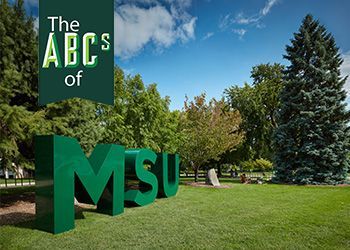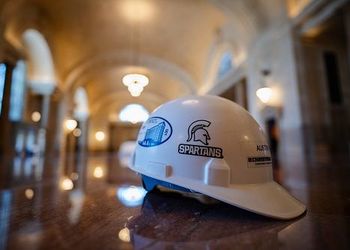Feature: MSU's College of Osteopathic Medicine

After four decades, MSU’s College of Osteopathic Medicine continues to follow its original mandate on how best to serve the state.
It’s an iconic photo. Michigan Governor William Milliken, with smile broad and pen in hand, is surrounded by ten legislators and physicians. At that instant, by Public Act 162 of 1969, the legislation that ultimately created the Michigan State University College of Osteopathic Medicine was brought to life. Core to that legislation was a mandate: This new medical school must provide the physicians that Michigan most needs.
At that point, few knew the true importance of those pen strokes. More than four decades later, MSUCOM, the first osteopathic college ever to be state-assisted and the first to be located at a major university, has fulfilled that mission. Year after year, the college’s leadership and faculty have worked diligently to maximize the likelihood that graduates will provide the medical services Michigan needs in the quantity Michigan needs with the quality Michigan needs.
It has paid off. To date, great pride rises from the following bald facts:
? For ten years straight, MSUCOM has ranked in the top 5 percent of all medical schools in the nation—D.O. and M.D.—for primary care education, according toU.S.News & World Report.
? MSUCOM recruits from Michigan. In the 2009 entering class, for example, 93 percent of the students were residents of the state.
? Fully two-thirds of the college’s 4,137 alumni remain in Michigan to practice—a higher proportion than any other medical school in the state.
? More than half of MSUCOM graduates are providing primary care, serving as the guardians and coordinators of healthcare for their patients.
In short, from Marquette to Monroe, MSUCOM alumni are working and serving in every portion of our state—in inner cities and small towns, in suburban neighborhoods and rural areas, on reservations and military bases. This impact will only increase with MSUCOM’s expansion (see sidebar).
From its beginning, the college has been indebted to the osteopathic profession. A consortium of community-based affiliated hospitals was established in the Statewide Campus System (SCS); at the time it was so innovative that its developers were asked to testify before Congress. There are now 31 hospitals in the SCS, and with our more than 2,400 volunteer physician faculty, they do the heavy lifting of our clinical education. These generous resources have allowed the college to expand because of assurance that COM students will learn from the best clinicians, and that there will be more than sufficient numbers of internships and residencies available for them when they graduate.
Many COM alumni have noteworthy accomplishments: Steven Pitt, the forensic psychiatrist who worked on the Columbine High School, JonBenet Ramsey, and Kobe Bryant cases; Sister Anne Brooks, who graduated to choose the poorest community in the nation where her practice and community-building have received national recognition; Joyce Johnson, former surgeon general of the Coast Guard; and many, many more.
The MSU College of Osteopathic Medicine has been a leader in developing research in a profession that traditionally has emphasized clinical care, and leads all other osteopathic colleges in the nation in our level of National Institutes of Health funding, a common marker for research excellence.
Over the years internationally recognized scientists have served in the college’s faculty. Veronica Maher, the first person ever to identify that chemical and radiation damage to DNA causes mutations and ultimately cancer, and Justin McCormick, an expert on DNA repair, rank in the top five percent of cumulative funding from the National Institutes of Health. Terrie Taylor (see Spartan Saga), working in Malawi, has become the world’s focal point for studies and treatment of cerebral malaria in children; MSUCOM constructed a building to house that African nation’s first MRI, which was donated by General Electric. An array of studies by MSUCOM faculty include epilepsy in Zambia, neurocognitive development and AIDS in Uganda, vaccine development, orthopedic research, biomechanics, Parkinson’s disease, Alzheimer’s disease, stroke, hypertension and more.
Building for the future, MSUCOM in 1979 developed the first ever joint D.O.-Ph.D. program to provide exceptional students the opportunity to become physician-scientists. Today, this challenging program has 25 students enrolled, learning to be both doctors and researchers, and using the skills to improve the knowledge base and practice of medicine.
MSUCOM Spartans can now be found making a difference around the globe. The college’s Institute of International Health (IIH) develops research overseas, such as environmental health in the Balkans and viral disorders in Egypt. Under the new leadership of Reza Nassiri, IIH has a rapidly expanding network of affiliations on five continents, where faculty and student exchanges, medical missions, and study abroad opportunities are available. Typical of such outreach is the establishment of an MSUCOM HIV clinic in the Dominican Republic under the leadership of Peter Gulick.
Today the footprint of the MSU College of Osteopathic Medicine is large—teaching, learning, leading, caring, healing, and serving. The college has not only met its mandate by providing the physicians Michigan needs, it is also multiplying its impact by providing the physicians that the world needs.
SIDEBAR: GROWING UP TO THE CHALLENGE
Remaining responsive to the needs of a state in an area as complex as healthcare education has not been easy. It requires eyes on the horizon, hands on the wheel, and the pedal to the metal. That is why the MSUCOM has recently launched an expansion of its first- and second-year program to two sites in southeast Michigan—at the Detroit Medical Center downtown and at the Macomb University Center in Clinton Township.
MSUCOM Dean William D. Strampel was among the first to counter the continuing projections of a physician oversupply and to anticipate the impact of two trends on a collision course: the aging Baby Boomers who would require more and more healthcare, and the aging Baby Boomer physicians who would be retiring. Before the national and state blue-ribbon commissions had finished their documentation of major shortages by 2020 for both Michigan and the nation, Strampel was already thinking seriously about expansion. Considering osteopathic education requires a minimum of four years of undergraduate education, four years of medical school, and two to six years of residency training before physicians are ready for practice, the timeline was already short. In addition, Fee Hall could no longer handle additional students.
Southeast Michigan was the logical area for expansion for the College of Osteopathic Medicine. It includes the largest proportion of Michigan’s population, a high proportion of those who are medically underserved, and more than half of MSUCOM’s 31 affiliated teaching hospitals and 2,400 clinical faculty. The model provided increased opportunities for our students to care for people from a variety of cultures and backgrounds, increased accessibility to our educational programs for residents of southeast Michigan, and increased likelihood that committed and highly competent physicians would remain to care for the medically underserved in southeastern Michigan.
As the news got out in 2006, a frenzy started. By word of mouth only, MSU received no less than 18 credible and unsolicited proposals for the college to locate in southeast Michigan—from colleges, businesses, real estate developers, hospitals and more. Communities got involved, with government, healthcare professionals and hospitals, industry, unions, social service agencies, educators and others joining together to attract the college.
Though the original plan had called for only one expansion site, in May 2007 the MSU Board of Trustees selected two—one at Macomb University Center, part of
Macomb Community College in Clinton Township, and one at the former Hutzel Hospital at Detroit Medical Center downtown. In addition, the board doubled the size of the expansion, from 50 students total to 50 at each site. In many ways the two sites offer complementary milieux for osteopathic medical education. Macomb offers an innovative, state-of-the-art educational institution situated among a high concentration of osteopathic physicians and partner hospitals. The DMC proffers an outstanding medical environment which will help students appreciate the needs of an underserved urban population.
Following Board of Trustee approval in May 2007, the college began immediately to obtain accreditation for the expansion from the Commission on Osteopathic College
Accreditation, a process that took until September 2008.
In the meantime, MSUCOM administrators, faculty and staff went into a frenzy of their own. Facilities (including histology, anatomy and osteopathic manipulative medicine laboratories, classrooms, study areas, offices and a myriad of technology) had to be prepared—twice. DMC renovated hospital space; Macomb constructed a dedicated building for the college. We coordinated curricula, hired and reassigned faculty and staff, extended student and financial aid services, hawk-eyed budgets, built relationships, and recruited students. By June 2009, 315 fresh osteopathic medical students crossed the stage at their White Coat Ceremony, celebrating their official welcome into the college. A few days later the class was split: two-thirds in East Lansing, and one-sixth each at DMC and Macomb.
The teaching model for three sites is unique in the extent to which it uses technology, but every effort is made so that students have the same quality educational experience. The three locations are linked electronically so all students in the class see the same lectures, discuss the same issues, and take the same tests at the same time. The instruction may originate from any of the three sites. With the lights down, the PowerPoint presentations on screen, the voice of the lecturer filling the room, and their classmates asking questions of the faculty, students quickly forget that the speaker may be 90 miles distant. Even class meetings, meetings of student organizations, and faculty and administrative meetings are held electronically. In addition, faculty at each site are available for face-to-face interactions. Student evaluations of the experience are positive, and the college is carefully evaluating both process and product.
One of the main reasons the expansion could be handled expeditiously is that it is extremely cost-effective. Faculty and staff impact is maximized, facilities are leased instead of owned, and the extra tuition generated by the expansion will quickly make it self-supporting. The value of the expansion and how it was achieved were recognized by the Michigan Health Council, which gave MSUCOM its Building Michigan’s Workforce in Health Award in 2008.
If the past is a predictor of the future, this expansion could well provide nearly 100 additional osteopathic physicians each year, about 65 of whom will remain in Michigan, caring for our people, enhancing our communities, and making good on the mandate to provide the physicians that Michigan needs.
A SPECIAL KIND OF PIONEER
It took a special kind of pioneer to be part of the inaugural class at MSUCOM Detroit Medical Center and Macomb University Center sites. At the time the Class of 2013 was being recruited, faculty and staff at the sites were working in temporary facilities, and tours for prospective students often involved stretching the imagination. They were being asked to accept a new way of receiving medical education, which, though thoroughly tested on the MSU campus, had not been used to this extent before. They were to be Spartans, but Spartans far removed from the chimes of Beaumont Tower and the roars of the stadium.
But once in place, it took only weeks for the new classes to gel and to begin to impact the communities around them. They volunteered for community clean-ups, conducted health screens at the Eastern Market, exhibited at a robotics competition at a local high school, mentored students, raised funds and donated to charities, did health education among elementary students. In short, they maintained the long-standing tradition of exceptional voluntarism that has characterized MSUCOM students—and alumni—from the beginning.



